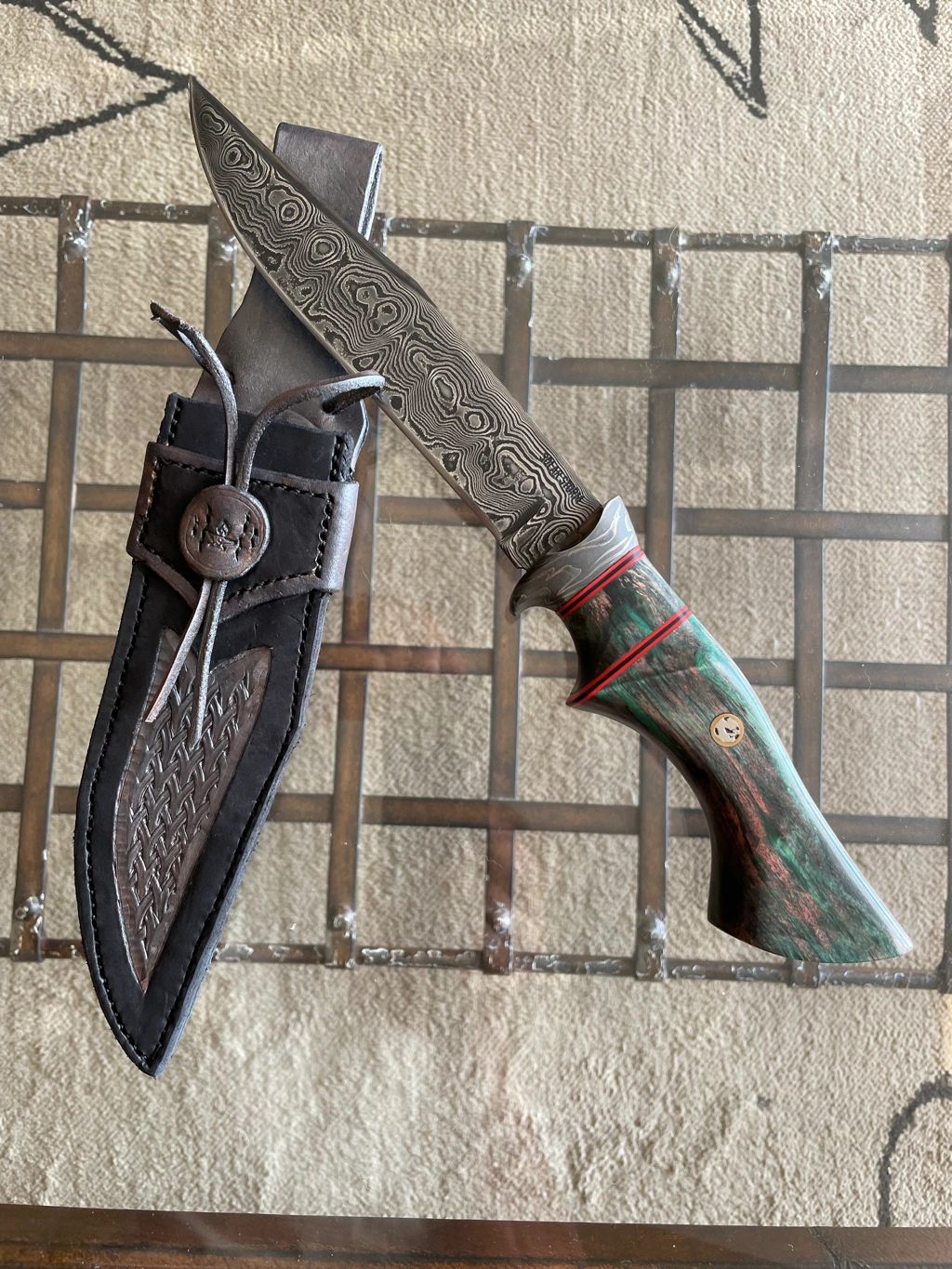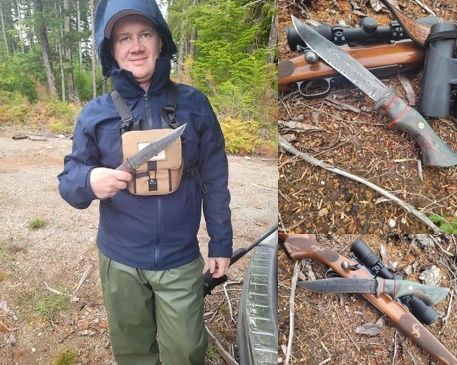This is another one I completed last year.
The Nijmegen Seax is named after the region of the Netherlands where it was found. The original dates to the mid-6th century and is mostly iron, or low-carbon steel. The Seax is significant because it has an iron forward guard/bolster plate and an iron pommel. While these features are not unheard of in the acheological record, they are not typical in this age range. A photo of the original ia attached.
My version closely matches the original in profile and dimensions. I am a few millimeters short on the length due to an unfortuante accident that curled the tip, which had to be reground, and a millimeter narrower at the spine.
Final stats: 322 mm blade length, 33 mm blade width, 6 mm thick, 452 mm OAL
Anyway, the blade is pattern-welded 1095/15N20 in half-ladder. The handle is walrus ivory and walnut burl with cast bronze hardware. The handle carvings are typical of Merovingian decorations called "occuli" by archeologists for their resemblance to eyes. My version can be seen in this gallery:
https://imgur.com/gallery/psmWOpx
“So I'm lightin' out for the territory, ahead of the scared and the weak and the mean spirited, because Aunt Sally is fixin’ to adopt me and civilize me, and I can't stand it. I've been there before.”
That's pretty spectacular.
I can't imagine the hours put into that.
is that a wolves tooth pattern you put in that?
Bob Bryenton
Solar Storm Group Ltd.
Phone: (780) 953-0016
Email: [email protected]
https://www.solarstorm.ca
“The only way of finding the limits of the possible is by going beyond them into the impossible" -- Arthur C. Clarke
Joshua,
The knife is beautiful! It has a much more gentle and curved drop point that other seaxes that I have seen. For a half-ladder pattern, do you grind or press the grooves on only one side of the blade, and then press/hammer flat? Also, the 'occuli' in the walrus ivory, is that a form of scrimshaw? I couldn't find any information on how it is done. Hope to make something like that when I get to your level.
Thank you Karl. Yes it took some work. The 300+ layer billet sat in my shop for a couple of years with the pattern cut, but not finished forging before I decided what to do with it.
Wendell, this pattern goes by wolf's tooth or half-ladder. I chose to call this half-ladder because in Seax typology, the wolf's tooth is a very specific pattern (especially in Nordic weaponry) made by notching two different bars and fitting them into each other before forge welding them together. See attached photo. Typically in Norse weaponry, this was done with a high-phosporus bar and a low phosphorus bar to get the color contrast. The high-P iron bar etches white and looks like sharp teeth.
Sterling, yes, the half-ladder is made by creating grooves that are deeper on the edge side than they are on the spine side. It really has to be cut in to work right and the grooves have to go from edge to spine. Then the blade is forged out. As you flatten out the edge, it grows in length. So you have to thin down the spine to straighten it out and push the layers down to keep the visual effect. The occuli were cut using a tool I made from a piece of 1/8" round rod. I flattened out one end, but offset it to one side. Then I cut a V in the flat spot and filed the two prongs to points. It now works like a compas or a pair of dividers to create the circle with the center dot by spinning it like a drill bit. The depressions are filled with Fiebing's Antique finish.
I was honored, and quite surprised, when this blade won two awards at the OKG show this weekend. Phot in the next post.
“So I'm lightin' out for the territory, ahead of the scared and the weak and the mean spirited, because Aunt Sally is fixin’ to adopt me and civilize me, and I can't stand it. I've been there before.”
This blade won the competition for Best Fighter and for Best Forged Blade. I was truly stunned. The announcements were made, but I couldn't hear them. All I heard was "go pick up your blades from the judging room". There were some very beautiful blades in that category, so I assumed I didn't win. I picked up the three blades I entered in three different categories and went back to my table. A half-hour later, the show photographer showed up and asked me where my plaques were! I looked at him like he had antlers growing out of his head. When I texted my wife this photo, her only response was "You need to charge more for it now".
“So I'm lightin' out for the territory, ahead of the scared and the weak and the mean spirited, because Aunt Sally is fixin’ to adopt me and civilize me, and I can't stand it. I've been there before.”
Sterling, I forgot to address your observation about the blade profile being a softer dropped point than other Seaxes. This profile is the typical point profile from the pre-Anglo-Saxon era when the clipped point, or broken back, became the norm. The Seax is a very old blade form and predominated European weaponry from after the Roman era through the Anglo-Saxon era. Somewhere around 1100 years.
The broken back Seax became more popular and I think it is the precursor to the American Bowie. The Anglo-Saxon clip is much more pronounced and much straighter than the sublte and often curved clip on a Bowie.
“So I'm lightin' out for the territory, ahead of the scared and the weak and the mean spirited, because Aunt Sally is fixin’ to adopt me and civilize me, and I can't stand it. I've been there before.”
I just got the pro-pics back from Philip Schrei photograpy. He did a wonderful job of capturing the pattern in the steel and the grainof the wood burl.
Another shot
Solo knife shot attached
“So I'm lightin' out for the territory, ahead of the scared and the weak and the mean spirited, because Aunt Sally is fixin’ to adopt me and civilize me, and I can't stand it. I've been there before.”
Ever since I slid my hand down my knife blade when I was gutting a deer at a young age I swore to always (always) make weapons with a guard. Is that a poor perspective?
It is something to think about when choosing and shaping the handle. This may surprise you, but what we call a guard is a relatively new addition to knife design when you consider how many thousands of years humans have been making knives.There are many cultures that never developed a guard as we know it, and still make knives without anything remotely like a guard.
The Seax is a very large family of knives and long blades that most people would call swords. This was the standard blade form across most of Europe from post-Roman Empire to the 1100's.
Very few full handles have survived but the ones that have typically come in two varieties. The most common seems to be handles that are narrower in the center than they are at each end. This stops the hand from sliding forward in a thrust and stops the blade from flying away in a swinging motion. The handle cross section is also shaped more like a modern ax handle, in an apple seed shape.
Is it a poor choice to try and make style knives early?
As for your penchant for unique designs, that's a wonderful attribute to have. However, I think it is virtually impossible to make a "unique" knife design in this day and age. It's all been done before. This is an art form and like most artists we learn by copying other artists. The musician doesn't start out composing original music, they start by playing songs that already exist and learning the mechanics of their instrument and how melodies, harmonies, and rhythm combine. Knife making is no different. As a new maker, you should probably work on recreating standard forms that have passed the test of time. There is a reason some knife forms are commonplace and have existed for hundreds of years. It's because they work. There is still plenty of room for personal expression in creating a 4-inch drop-point hunter with a bird head handle. I think this is what those local masters were trying to tell you.
"Form follows function" we like to say. A really wild form is only useful as a wall hanger if it doesn't perform well for the intended purpose. If the intended purpose is simply to create a wild form, then that is OK. Some people like to collect what the industry calls "Fantasy Blades" and they do nothing but look cool. The hard truth is you cannot make any money making these types of knives by forging and hand crafting because they sell for $29.95 all over the Internet.
Ask yourself some questions. Would you take that knife you show above into the field and clean game with it? Would it be your first choice? What is the intended purpose of that knife? Is it useful for that purpose, or is there a better design?
“So I'm lightin' out for the territory, ahead of the scared and the weak and the mean spirited, because Aunt Sally is fixin’ to adopt me and civilize me, and I can't stand it. I've been there before.”
Quote: “Ask yourself some questions. Would you take that knife you show above into the field and clean game with it? Would it be your first choice? What is the intended purpose of that knife? Is it useful for that purpose, or is there a better design?”
I actually got goose bumps when I got this review of the 2nd knife I sold.
“Amazing look and feel, with even a better utility.
Broke open a deers ribcage without a problem, hacked through the knuckle joints, and still skinned the deer after easily.
After a quick polish after all that it diced the meat for a grinder, and is ready to go for spring bear.
I absolutely love it, and it is nice to have a knife that one can have pride in.
Ben”
Bob Bryenton
Solar Storm Group Ltd.
Phone: (780) 953-0016
Email: [email protected]
https://www.solarstorm.ca
“The only way of finding the limits of the possible is by going beyond them into the impossible" -- Arthur C. Clarke



